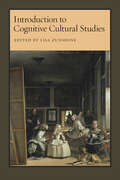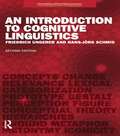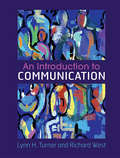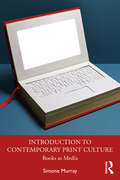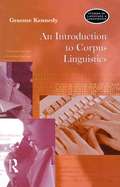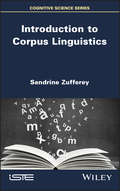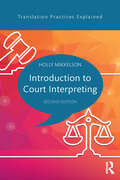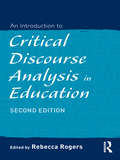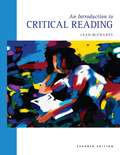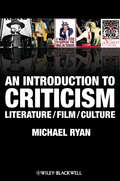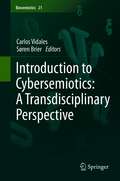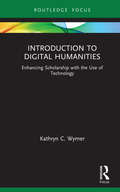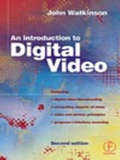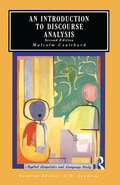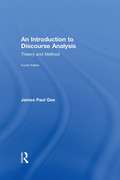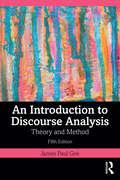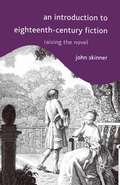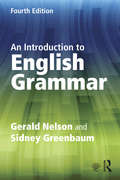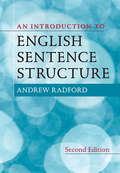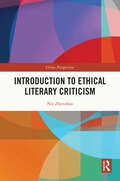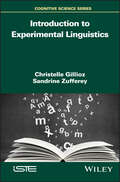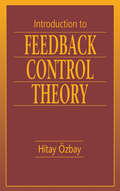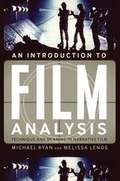- Table View
- List View
Introduction to Cognitive Cultural Studies
by Lisa ZunshineDrawing on the explosion of academic and public interest in cognitive science in the past two decades, this volume features articles that combine literary and cultural analysis with insights from neuroscience, cognitive evolutionary psychology and anthropology, and cognitive linguistics. Lisa Zunshine’s introduction provides a broad overview of the field. The essays that follow are organized into four parts that explore developments in literary universals, cognitive historicism, cognitive narratology, and cognitive approaches in dialogue with other theoretical approaches, such as postcolonial studies, ecocriticism, aesthetics, and poststructuralism. Introduction to Cognitive Cultural Studies provides readers with grounding in several major areas of cognitive science, applies insights from cognitive science to cultural representations, and recognizes the cognitive approach’s commitment to seeking common ground with existing literary-theoretical paradigms. This book is ideal for graduate courses and seminars devoted to cognitive approaches to cultural studies and literary criticism.Contributors: Mary Thomas Crane, Nancy Easterlin, David Herman, Patrick Colm Hogan, Bruce McConachie, Alan Palmer, Alan Richardson, Ellen Spolsky, G. Gabrielle Starr, Blakey Vermeule, Lisa Zunshine
An Introduction to Cognitive Linguistics (Learning about Language)
by Friedrich Ungerer Hans-Jorg SchmidLearning About Language is an exciting and ambitious series of introductions to fundamental topics in language, linguistics and related areas. The books are designed for students of linguistics and those who are studying language as part of a wider course. Cognitive Linguistics explores the idea that language reflects our experience of the world. It shows that our ability to use language is closely related to other cognitive abilities such as categorization, perception, memory and attention allocation. Concepts and mental images expressed and evoked by linguistic means are linked by conceptual metaphors and metonymies and merged into more comprehensive cognitive and cultural models, frames or scenarios. It is only against this background that human communication makes sense. After 25 years of intensive research, cognitive-linguistic thinking now holds a firm place both in the wider linguistic and the cognitive-science communities.An Introduction to Cognitive Linguistics carefully explains the central concepts of categorizaÂtion, of prototype and gestalt perception, of basic level and conceptual hierarchies, of figure and ground, and of metaphor and metonymy, for which an innovative description is provided. It also brings together issues such as iconicity, lexical change, grammaticalization and language teaching that have profited considerably from being put on a cognitive basis.The second edition of this popular introduction provides a comprehensive and accessible up-to-date overview of Cognitive Linguistics: Clarifies the basic notions supported by new evidence and examples for their application in language learning Discusses major recent developments in the field: the increasing attention paid to metonymies, Construction Grammar, Conceptual Blending and its role in online-processing. Explores links with neighbouring fields like Relevance Theory Uses many diagrams and illustrations to make the theoretical argument more tangible Includes extended exercises Provides substantial updated suggestions for further reading.
An Introduction to Communication
by Lynn H. Turner Richard WestPrioritizing brevity and clarity, this textbook introduces the study of communication through examples and applications of communication in a variety of contexts. With a unique focus on diversity and the impact of culture, each chapter opens with a case study that identifies a communication challenge, which the chapter addresses throughout, and concludes with questions that respond to that challenge. A consistent, organized structure with numerous features including fundamental issues, questions for understanding and analysis, theoretical insight (examining a particular relevant theory), and a skill set section, easily guides you through the foundations of the study of communication. Cross-referencing between chapters demonstrates the multidimensional nature of communication and the everyday talk sections demonstrate how each topic relates to technology, the workplace, or health issues. Offering a wealth of diverse examples from students' personal, professional, and online lives, this book teaches skills allowing students from all academic backgrounds to understand communication.
Introduction to Contemporary Print Culture: Books as Media
by Simone MurrayIntroduction to Contemporary Print Culture examines the role of the book in the modern world. It considers the book’s deeply intertwined relationships with other media through ownership structures, copyright and adaptation, the constantly shifting roles of authors, publishers and readers in the digital ecosystem and the merging of print and digital technologies in contemporary understandings of the book object. Divided into three parts, the book first introduces students to various theories and methods for understanding print culture, demonstrating how the study of the book has grown out of longstanding academic disciplines. The second part surveys key sectors of the contemporary book world – from independent and alternative publishers to editors, booksellers, readers and libraries – focusing on topical debates. In the final part, digital technologies take centre stage as eBook regimes and mass-digitisation projects are examined for what they reveal about information power and access in the twenty-first century. This book provides a fascinating and informative introduction for students of all levels in publishing studies, book history, literature and English, media, communication and cultural studies, cultural sociology, librarianship and archival studies and digital humanities.
An Introduction to Corpus Linguistics (Studies in Language and Linguistics)
by Graeme KennedyThe use of large, computerized bodies of text for linguistic analysis and description has emerged in recent years as one of the most significant and rapidly-developing fields of activity in the study of language. This book provides a comprehensive introduction and guide to Corpus Linguistics. All aspects of the field are explored, from the various types of electronic corpora that are available to instructions on how to design and compile a corpus. Graeme Kennedy surveys the development of corpora for use in linguistic research, looking back to the pre-electronic age as well as to the massive growth of computer corpora in the electronic age.
Introduction to Corpus Linguistics
by Sandrine ZuffereyOver the past decades, the use of quantitative methods has become almost generalized in all domains of linguistics. However, using these methods requires a thorough understanding of the principles underlying them. Introduction to quantitative methods in linguistics aims at providing students with an up-to-date and accessible guide to both corpus linguistics and experimental linguistics. The objectives are to help students developing critical thinking about the way these methods are used in the literature and helping them to devise their own research projects using quantitative data analysis.
Introduction to Court Interpreting (Translation Practices Explained)
by Holly MikkelsonAn Introduction to Court Interpreting has been carefully designed to be comprehensive, accessible and globally applicable. Starting with the history of the profession and covering the key topics from the role of the interpreter in the judiciary setting to ethical principles and techniques of interpreting, this text has been thoroughly revised. The new material covers: remote interpreting and police interpreting; role-playing scenarios including the Postville case of 2008; updated and expanded resources. In addition, the extensive practical exercises and suggestions for further reading help to ensure this remains the essential introductory textbook for all courses on court interpreting
An Introduction to Critical Discourse Analysis in Education
by Rebecca RogersAccessible yet theoretically rich, this landmark text introduces key concepts and issues in critical discourse analysis and situates these within the field of educational research. The book invites readers to consider the theories and methods of three major traditions in critical discourse studies – discourse analysis, critical discourse analysis, and multimodal discourse analysis -- through the empirical work of leading scholars in the field. Beyond providing a useful overview, it contextualizes CDA in a wide range of learning environments and identifies how CDA can shed new insights on learning and social change. Detailed analytic procedures are included – to demystify the process of conducting CDA, to invite conversations about issues of trustworthiness of interpretations and their value to educational contexts, and to encourage researchers to build on the scholarship in critical discourse studies. This edition features a new structure; a touchstone chapter in each section by a recognized expert (Gee, Fairclough, Kress); and a stronger international focus on both theories and methods. NEW! Companion Website with Chapter Extensions; Interviews; Bibliographies; and Resources for Teaching Critical Discourse Analysis.
An Introduction to Critical Reading
by Leah MccraneyThis unique college reading text gives students experience reading and evaluating poetry, short stories, essays, and textbook chapters. An innovative Instructor's Manual gives instructors a wealth of teaching ideas and background material on each piece with a focus on critical thinking.
An Introduction to Criticism
by Michael RyanAn accessible and thorough introduction to literary theory and contemporary critical practice, this book is an essential resource for beginning students of literary criticism.Covers traditional approaches such as formalism and structuralism, as well as more recent developments in criticism such as evolutionary theory, cognitive studies, ethical criticism, and ecocriticismOffers explanations of key works and major ideas in literary criticism and suggests key elements to look for in a literary textAlso applies critical approaches to various examples from film studiesHelps students to build a critical framework and write analytically
Introduction to Cybersemiotics: A Transdisciplinary Perspective (Biosemiotics #21)
by Carlos Vidales Søren BrierThis book traces the origins and evolution of cybersemiotics, beginning with the integration of semiotics into the theoretical framework of cybernetics and information theory. The book opens with chapters that situate the roots of cybersemiotics in Peircean semiotics, describe the advent of the Information Age and cybernetics, and lay out the proposition that notions of system, communication, self-reference, information, meaning, form, autopoiesis, and self-control are of equal topical interest to semiotics and systems theory. Subsequent chapters introduce a cybersemiotic viewpoint on the capacity of arts and other practices for knowing. This suggests pathways for developing Practice as Research and practice-led research, and prompts the reader to view this new configuration in cybersemiotic terms. Other contributors discuss cultural and perceptual shifts that lead to interaction with hybrid environments such as Alexa. The relationship of storytelling and cybersemiotics is covered at chapter length, and another chapter describes an individual-collectivity dialectics, in which the latter (Commind) constrains the former (interactants), but the former fuels the latter. The concluding chapter begins with the observation that digital technologies have infiltrated every corner of the metropolis - homes, workplaces, and places of leisure - to the extent that cities and bodies have transformed into interconnected interfaces. The book challenges the reader to participate in a broader discussion of the potential, limitations, alternatives, and criticisms of cybersemiotics.
Introduction to Digital Humanities: Enhancing Scholarship with the Use of Technology (Routledge Focus on Literature)
by Kathryn C. WymerIntroduction to Digital Humanities is designed for researchers, teachers, and learners in humanities subject areas who wish to align their work with the field of digital humanities. Many institutions are encouraging digital approaches to the humanities, and this book offers guidance for students and scholars wishing to make that move by reflecting on why and when digital humanities tools might usefully be applied to engage in the kind of inquiry that is the basis for study in humanities disciplines. In other words, this book puts the "humanities" before the "digital" and offers the reader a conceptual framework for how digital projects can advance research and study in the humanities. Both established and early career humanities scholars who wish to embrace digital possibilities in their research and teaching will find insights on current approaches to the digital humanities, as well as helpful studies of successful projects.
Introduction to Digital Video
by John WatkinsonCovers the essential fundamentals of digital video: from video principles, to conversion, compression, coding, interfaces and output. Written for television professionals needing to apply digital video systems, equipment and techniques to multimedia and /or digital TV applications, as well as for computer system designers, engineers, programmers, or technicians needing to learn how to apply digital video to computer systems and applications. The text is based on the acclaimed industry `bible' The Art of Digital Video, but covers only the essential parts of this larger reference work. It starts right from the basics from what a digital signal is to the how digital video can be applied. John Watkinson is an international consultant in Audio, Video and Data Recording. He is a fellow of the AES, a member of the British Computer Society and Chartered Information Systems Practitioner. He presents lectures, seminars, conference papers and training courses worldwide. He is author of many other Focal press books including MPEG2, Art of Digital Video, Art of Digital Audio, Art of Sound Reporduction, Introduction to Digital Audio, Television Fundamentals and Audio for Television. He is also co-author of the Digital Interface Handbook and a contributor to The Loudspeaker and Headphone Handbook.
An Introduction to Discourse Analysis (Applied Linguistics and Language Study)
by Malcolm Coulthard C. N. CondlinThe central concern of this book is the analysis of verbal interaction or discourse. This first six chapters report and evaluate major theoretical advances in the description of discourse. The final chapters demonstrate how the findings of discourse analysis can be used to investigate second-language teaching and first-language acquisition and to analyse literary texts.
An Introduction to Discourse Analysis: Theory and Method
by James Paul GeeDiscourse analysis considers how language, both spoken and written, enacts social and cultural perspectives and identities. Assuming no prior knowledge of linguistics, An Introduction to Discourse Analysis examines the field and presents James Paul Gee's unique integrated approach which incorporates both a theory of language-in-use and a method of research. An Introduction to Discourse Analysis can be used as a stand-alone textbook or ideally used in conjunction with the practical companion title How to do Discourse Analysis: A Toolkit. Together they provide the complete resource for students studying discourse analysis. Updated throughout, the fourth edition of this seminal textbook also includes two new chapters: 'What is Discourse?' to further understanding of the topic, as well as a new concluding section. A new companion website www.routledge.com/cw/gee features a frequently asked questions section, additional tasks to support understanding, a glossary and free access to journal articles by James Paul Gee. Clearly structured and written in a highly accessible style, An Introduction to Discourse Analysis includes perspectives from a variety of approaches and disciplines, including applied linguistics, education, psychology, anthropology and communication to help students and scholars from a range of backgrounds to formulate their own views on discourse and engage in their own discourse analysis. This is an essential textbook for all advanced undergraduate and postgraduate students of discourse analysis.
An Introduction to Discourse Analysis: Theory and Method
by James Paul GeeThis bestselling textbook provides a comprehensive guide to conducting discourse analysis. The book outlines Gee’s approach, which involves examining how language is used in context to construct meaning, identities, relationships, and social practices.The theoretical framework is built around seven "building tasks" that language performs: significance, practices, identities, relationships, politics, connections, and sign systems and knowledge. Gee introduces six "tools of inquiry" for analyzing these tasks: situated meanings, social languages, figured worlds, intertextuality, Discourses, and Conversations.Methodologically, Gee emphasizes the importance of context and the reciprocal relationship between language and context. He discusses transcription, outlines the components of an "ideal" discourse analysis, and addresses issues of validity.The book provides practical guidance on analyzing various aspects of language, such as intonation units, stanzas, and the overall organization of oral and written texts. Gee uses interview data to demonstrate how identities and socially situated meanings are constructed through language.This new edition is updated throughout with new examples and a new chapter on multimodal discourse analysis, demonstrating how Gee’s approach can be applied to texts that combine language with other modes of communication, like images or video. Overall, the book equips readers with a robust toolkit for systematically analyzing discourse.
An Introduction to Eighteenth-Century Fiction: Raising the Novel
by John SkinnerThe formal and expressive range of canonic eighteenth-century fiction is enourmous: between them Defoe, Richardson, Fielding, Smollett and Sterne seem to have anticipated just about every question confronting the modern novelist; and Aphra Behn even raises a number of issues overlooked by her male successors. But one might also reverse the coin: much of what is present in these writers will today seem remote and bizarre. There is, in fact, only one novelist from the 'long' eighteenth century who is not an endangered species outside the protectorates of university English departments: Jane Austen. Plenty of people read her, moreover, without the need for secondary literature. These reservations were taken into account in the writing of this book. An Introduction to Eighteenth Century Fiction is a comprehensive and accessible introduction to English fiction from Aphra Behn to Jane Austen. It deals with novel criticism, canon formation and relations between genre and gender. The second part of the book contains an extensive discussion of Richardson and Fielding, followed by paired readings of major eighteenth-century novels, juxtaposing texts by Behn and Defoe, Sterne and Smollett, Lennox and Burney among others. The various sections of the book, and even the individual chapters, may be read independently or in any order. Works are discussed in a way intended to help students who have not read them, and even engage with some who never will. The author consumes eighteenth-century fiction avidly, but has tried to write a reader-friendly survey for those who may not.
An Introduction to English Grammar
by Sidney Greenbaum Gerald NelsonAn Introduction to English Grammar provides a comprehensive overview of all aspects of English grammar. The first part of the book ('The Grammar') provides a step-by-step introduction to the key topics in English grammar. The second part ('The Applications') shows how a grasp of these topics can be helpful in resolving usage problems, in developing a clear writing style, and in mastering punctuation and spelling. A whole chapter, 'English in Use', is devoted to illustrating the grammatical features of a wide range of modern text types, including emails, Facebook pages, and 'tweets'. It also looks at the special grammatical features of English in everyday conversation. Each chapter is followed by two sets of exercises. The first set can be used in self-study or in the classroom. The second set deals with more advanced topics, and can be used for classroom discussion or essay writing. This fourth edition has been fully revised and updated and includes: clearer descriptions and improved presentation new material on word structure and word formation new exercises, examples and extracts updated further reading Assuming no prior knowledge of English grammar, this book is ideal for beginning students on a one-semester course and provides everything a student needs on the theory and practice of English usage. A comprehensive Glossary of grammatical terms is included and a website provides invaluable additional exercises.
An Introduction to English Grammar
by Gerald Nelson Sidney GreenbaumAn Introduction to English Grammar provides a comprehensive overview of all aspects of English grammar. The first part of the book (‘The Grammar’) provides a step-by-step introduction to the key topics in English grammar. The second part (‘The Applications’) shows how a grasp of these topics can be helpful in resolving usage problems, in developing a clear writing style, and in mastering punctuation and spelling. A whole chapter, ‘English in Use’, is devoted to illustrating the grammatical features of a wide range of modern text types, including emails, Facebook pages, and ‘tweets’. It also looks at the special grammatical features of English in everyday conversation. Each chapter is followed by two sets of exercises. The first set can be used in self-study or in the classroom. The second set deals with more advanced topics, and can be used for classroom discussion or essay writing. This fourth edition has been fully revised and updated and includes: clearer descriptions and improved presentation new material on word structure and word formation new exercises, examples and extracts updated further reading Assuming no prior knowledge of English grammar, this book is ideal for beginning students on a one-semester course and provides everything a student needs on the theory and practice of English usage. A comprehensive Glossary of grammatical terms is included and a website provides invaluable additional exercises.
An Introduction to English Sentence Structure
by Andrew RadfordThis new edition of Andrew Radford's outstanding resource for students is a step-by-step, practical introduction to English syntax and syntactic principles, written by a globally-renowned expert in the field. Assuming little or no prior background in syntax, Radford outlines key concepts and how they can be used to describe various aspects of English sentence structure. Each chapter contains core modules focusing on a specific topic, a summary recapitulating the main points of the chapter, and a bibliographical section providing references to original source material. This edition has been extensively updated, with new analyses, exercise materials, references and a brand-new chapter on adjuncts. Students will benefit from the online workbook, which contains a vast amount of exercise material for each module, including self-study materials and a student answerbook for these. Teachers will value the extensive PowerPoints outlining module contents and the comprehensive teacher answerbook, which covers all workbook and PowerPoint exercises.
Introduction to Ethical Literary Criticism (China Perspectives)
by Nie ZhenzhaoThis title is a thorough introduction to ethical literary criticism, defined as a critical methodology to interpret literature from the perspective of ethics, with the whole set of concepts and theories elucidated and textual analyses provided. While building on ideas from both western ethical criticism and the Chinese tradition of moral criticism, ethical literary criticism acts as a counterpoint to the former's lack of theoretical foundations and applicable methodologies and the latter's tendency to make subjective moral judgments. Developed into a coherent theoretical framework, it asserts the ethical nature and edifying function of literature and thereby seeks to highlight in the literary text the ethical relationship and moral order among human beings and within society in the historical context. Though provocative to a degree, the arguments and methodological toolbox used inject a unique ethical dimension into literary criticism and will help readers understand anew the ethical and social potency of literature. The book's theoretical elucidation, examples from practical criticism and introduction to key terminologies make this book an essential guide for students and general readers interested in ethical literary criticism and a valuable read for scholars of literary criticism, ethical criticism and literary theory.
Introduction to Experimental Linguistics
by Christelle Gillioz Sandrine ZuffereyThe use of experimental methodology in the field of linguistics has boomed in recent decades. However, implementation of such methods does require an understanding and mastery of specific theoretical and methodological principles. Introduction to Experimental Linguistics presents the key concepts of experimental linguistics in an accessible way, addressing, in turn: the application of experimentation in linguistics; the techniques most frequently used for the study of language; the methodological and practical aspects useful for the implementation of an experiment; and an introduction to the analysis of quantitative data derived from experiments. This didactic book combines the elements presented with examples drawn from the various fields of linguistics. It also includes a number of resources available for people who wish to implement an experimental study, more advanced reading suggestions, and revision questions along with their answer key.
Introduction to Feedback Control Theory
by Hitay OzbayThere are many feedback control books out there, but none of them capture the essence of robust control as well as Introduction to Feedback Control Theory. Written by Hitay Özbay, one of the top researchers in robust control in the world, this book fills the gap between introductory feedback control texts and advanced robust control texts.Introduction to Feedback Control Theory covers basic concepts such as dynamical systems modeling, performance objectives, the Routh-Hurwitz test, root locus, Nyquist criterion, and lead-lag controllers. It introduces more advanced topics including Kharitanov's stability test, basic loopshaping, stability robustness, sensitivity minimization, time delay systems, H-infinity control, and parameterization of all stabilizing controllers for single input single output stable plants. This range of topics gives students insight into the key issues involved in designing a controller.Occupying and important place in the field of control theory, Introduction to Feedback Control Theory covers the basics of robust control and incorporates new techniques for time delay systems, as well as classical and modern control. Students can use this as a text for building a foundation of knowledge and as a reference for advanced information and up-to-date techniques
An Introduction to Film Analysis: Technique and Meaning in Narrative Film
by Michael Ryan Melissa LenosAn Introduction to Film Analysis combines an introduction to filmmaking technique with rigorous and comprehensive training in film interpretation. Composed in an accessible style yet conversant with the latest, most advanced critical theories and methods, this innovative textbook can be reliably used on both the undergraduate and the graduate level. The book begins with chapters that familiarize students with the basic components of film technique. It connects technique to meaning and demonstrates, through numerous examples, how particular uses of film technique generate different meanings. Students will learn how films are made and how values are promoted, ideas communicated, and rhetorical arguments advanced through film technique. The second part of the book covers a range of interpretive methods, theories, and concerns. In each section, the author offers a sample reading of a film, followed by an "interpretive exercise" with suggestions for students to use in performing their own film interpretation. Carefully structured, beautifully written, and illustrated throughout, An Introduction to Film Analysis provides a thorough grounding in the subject for students around the world.
